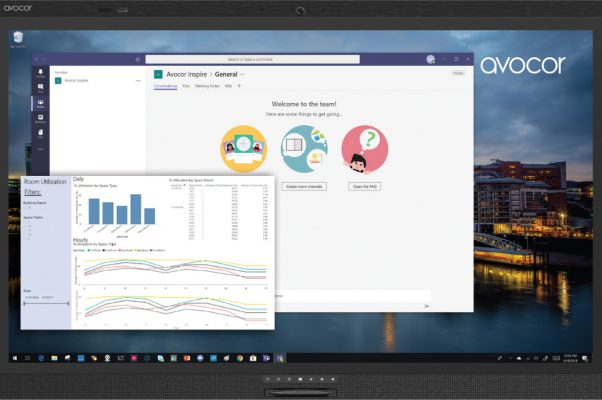Collaborating on Collaboration Technology Brings Innovation

A common topic discussed at many corporations is what can be done about meetings that too often start late, run late, and aren’t as productive as they could be. Technology appears to offer a solution, but if awkwardly designed, it can hinder as much as help.
Video teleconferencing and collaboration solutions have been around for years, but many are hard to use, offer poor video and audio quality, or simply don’t work. It’s challenging enough to collaborate when participants are in multiple locations, even more so when in different time zones. If technology doesn’t perform or is hard to use, it can affect productivity and return on investment.
Traditional collaboration solutions tend to be designed around the digital video display. They require customers and system integrators to piece together an end-to-end system using technology from multiple vendors. But this screen-centric approach doesn’t easily accommodate the way people typically work or the tools and applications they most often use.
What if, instead, collaboration systems worked more like a PC with a big screen—accessible by anyone, anywhere with standard desktop applications? And what if presentations were preloaded and meetings could begin as soon as the attendees walked into the conference room? Perhaps more meetings would start on time and collaboration could be more effective.
Collaboration Results in Innovation
Microsoft and Avocor teamed up to tackle these challenges and create opportunities with a new approach. The companies co-developed the first Windows-based collaboration solution by integrating their respective technologies and complementary expertise.
Together they created the Avocor Windows Collaboration Display (WCD), an all-in-one integrated video collaboration solution (Figure 1). And by making a Windows-based PC the heart and brain of the WCD, they brought the desktop experience to collaboration, enabling people to meet and work together—using common applications such as Microsoft Office, Teams, and Whiteboard.

The solution integrates a camera, stereo speakers, a far-field microphone array, and IoT sensors with a 65-inch Avocor video display. The sensors measure and upload room data to the Microsoft Azure Digital Twins platform, which uses spatial intelligence to model the relationships and interactions among people, places, and devices.
Combining that data with AI algorithms, facilities managers can make appropriate decisions based on meeting room trends such as space, lighting, and temperature to improve workspace comfort, productivity, as well as the efficiency of room reservations. This ability to use data to maximize resources in a smart building manner takes the solution beyond traditional collaboration systems.
“We’ve defined a new category of devices that disrupt and digitize workspaces in a positive way,” said Natalie Harris-Briggs, a Marketing Manager at Avocor. “You might say that when companies collaborate, they can improve how collaboration technology works.”
Sensors, Data Gathering, and AI
Avocor and Microsoft set about solving the problem of meetings starting late in a number of ways. A proximity sensor detects when people enter the room and automatically powers up the system. It can then start a scheduled presentation session using several different methods, all without anyone having to remember passwords or enter long meeting ID numbers. Instead, the system can start the meeting through facial recognition, scanning a company badge, or by voice command.
Once engaged, the WCD can instantly launch, for example, a PowerPoint or a video, preloaded before the scheduled meeting. And if the sensors detect no movement of people in the meeting room for more than 15 minutes, it can automatically label that room as available in the room booking system.
To simplify functionality, a single USB-C cable is all that’s needed for a presenter to connect his or her laptop to the WCD. The cable also transmits 4K video from the PC to the WCD, and provides touch system control, hardwired Internet access, and power to the laptop. The same cable can also be plugged into a different laptop, mid-session, without interrupting the meeting.
Included is an option to operate the WCD with an Intel® NUC mini-PC attached to the screen. This option not only helps ensure that the Windows OS is running when not connected to a laptop, it enables presenters to conveniently open files from a shared company drive, the cloud, or a USB-C stick by using the system’s mouse and keyboard.
And by incorporating touchscreen technology, the solution provides an interactive experience that enhances collaboration and presentations, whether one or multiple users engage with the display. “You can be working in Excel or PowerPoint on the WCD, and using your hands to move things, or zoom in and out on the screen,” said Mark Frost, a Marketing Manager at Intel®. “You can write on it with your finger, like you’re using a pen. It’s a tactile experience to share and involve people in the collaboration.”
Powering Digital Display Technology for the Enterprise
Intel® vPro™ and Intel Unite® provide an open platform to connect devices, operating systems, and displays. It supports unified communications plug-ins such as Skype for Business and Zoom, in-room controls, whiteboarding, and other applications that enhance collaboration.
Intel® Active Management Technology (AMT) enables IT organizations to remotely discover, repair, and help protect networked computing assets, making the system simple to manage from a central location. These Intel technologies offer the ability to remotely access the unit at the system level,regardless of power state or the condition of the OS. In that way, no one from IT must physically reboot the solution—saving time for all.
The developers also took cybersecurity best practices into account, leading to all content shared on the platform to be fully encrypted with 256-bit SSL security.
These innovations in security, collaboration, communication, presentation, and management systems demonstrate an important concept: Developers can reinvent product categories by approaching proven technologies from a new angle.